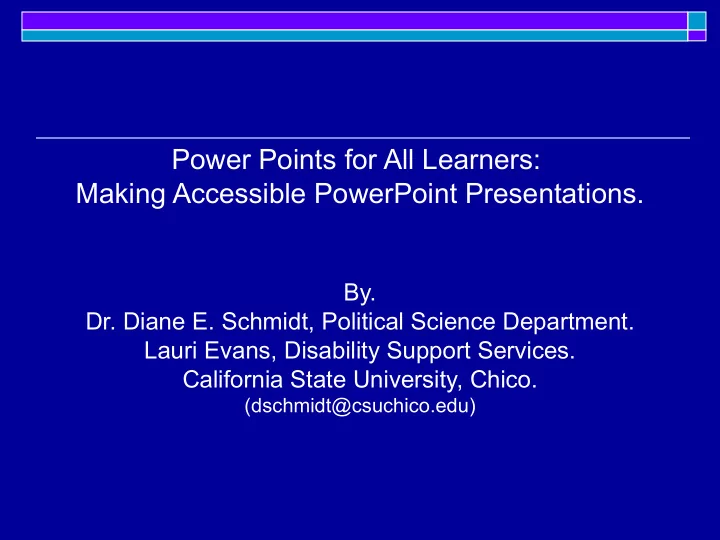

Power Points for All Learners: Making Accessible PowerPoint Presentations. By. Dr. Diane E. Schmidt, Political Science Department. Lauri Evans, Disability Support Services. California State University, Chico. (dschmidt@csuchico.edu)
UNIVERSAL DESIGN FOR LEARNING (UDL). Materials address differing learning styles. Programmatic—Equal opportunity for learning. Physical—Learning without special adaptation.
LEARNERS DIFFER. Physical. Programmatic. Organizational skills. Vision. Attention span, memory. Hearing. Literacy skills. Mobility. Native language. Fine motor skills. Ethnic background. Quality of health.
NEED FOR ACCESSIBLE POWERPOINTS . Section 508, Americans with Disabilities Act. Diversity creates need for inclusive techniques. Remove unintentional discrimination.
ADDRESSING IMPAIRMENTS: PROTECTED DISABILITIES. Auditory—slight hearing loss to deafness. Visual—low vision, color blindness, blindness. Cognitive—dyslexia, attention deficit disorder. Mobility—result of accidents or conditions
POWERPOINT AS A COMMUNICATION TOOL. Accessible. Inaccessible. Readability. Overcrowded text. Coherent. Inconsistent format. Simple. Gratuitous graphics. Intuitive. Contextual. Focused. Distracting, noisy.
TYPES OF PRESENTATIONS . Student generated—student to student. Instructional—faculty to students. Professional—specialist to public .
CRITERIA FOR ACCESSIBLE POWERPOINT PRESENTATIONS. Readability—write for intelligent nonspecialist. Usability—efficient, headline form text. Navigability—organized logically, classified.
BASIC FORMAT FOR ACCESSIBLE PRESENTATIONS: SLIDE LAYOUT. Adopt a high contrast template. Write the presentation in Outline View. Make sure all text is visible in Outline View Do not use red and green backgrounds
BASIC FORMAT FOR ACCESSIBLE PRESENTATIONS: FONTS. Fonts should be large, try size 28-40. Use sans serif fonts such as Arial or Tahoma. Color-code only to enhance labeled items. No red or green fonts, avoid flashing, flickering.
BASIC FORMAT FOR ACCESSIBLE PRESENTATIONS: TEXT. Each slide should have a title. Use 3 or 4 lines per slide, bullet them. Use 5-6 words per line, avoid wrapping text. Avoid long quotes or paragraphs of text.
BASIC FORMAT FOR ACCESSIBLE PRESENTATIONS: PUNCTUATION. Use periods at the end of each phrase. Capitalize first letter of bullets. Do not abbreviate or use contractions. Use acronyms only after defining them.
BASIC FORMAT FOR ACCESSIBLE PRESENTATIONS: IMAGES, OBJECTS. Use only for enhancing comprehension. Only one image or object in a slide at a time. Tag each using Alternative Text (Alt-Text). Describe image or object in full detail.
EXAMPLE OF IMAGE DESCRIPTION. DISABILITIES HELPED BY ACCESSIBLE POWERPOINT AUDITORY VISUAL COGNITIVE MOBILITY Reduces Reduces Reduces complexity, distractions, Reduces need dependence improves improves for dexterity on visual cues signing focus
BASIC FORMAT FOR ACCESSIBLE PRESENTATIONS: MEDIA, LINKS. Video must be described completely in Alt-Text. Audio must have a text transcript. Multimedia must be captioned. Hyperlinks used only if accessible, captioned as: http://pptmagic.com becomes the following
EXAMPLE OF LINK
ACCESSIBLE POWERPOINT PERFORMANCE AND PRINTING. Prepare handouts in grayscale, check contrast. Prepare copies of notes pages in grayscale. Arrange for sign language interpreter. Do not read slides or notes to the audience.
CONCLUSION. Standardizes approach regardless of context. Complies with UDL and Section 508 standards. Addresses physical, programmatic differences Eliminates visual, auditory, cognitive barriers.
RESOURCES Banks, Richard, Elizabeth Coombs, and Norman Coombs. 2005. Accessible PowerPoint on the web: Tools that can help. Center On Disabilities Technology and Persons With Disabilities Conference 2005. http://www.csun.edu/cod/conf/ 2005/proceedings/2402.htm. Burks, Michael and Cynthia Waddell. 2007. Accessible version of PowerPoint presentation . Seminar for a Web Without Barriers for People With Disabilities: eGovernment for everyone. Internet Society Disability and Special Needs Chapter. Buenos Aires, Argentina. http://www.isoc.org/ar/projectos/Cynthia.doc. Darling, Katie. 2002. Making training accessible: Universal Instructional Design . University of Tennessee. Center on Disability and Employment. http://www.cde.tennessee.edu/products/uid.pdf. Embry, Priscilla B., David R. Parker, Joan M. McGuire and Sally S. Scott. 2003. Postsecondary disability service providers' perceptions about implementing universal design for instruction. Journal of Post Secondary Education and Disability 18 (1) 34-48. Gugerty, John. 2006. Making PowerPoint presentations accessible . AHEAD 2006 Conference, San Diego, CA. Hofer, Mark, Robb Ponton, and Kathleen Swan. 2006. Reinventing PowerPoint: A new look at an old tool. Social Studies Research and Practice . 1(3): 457-464.
RESOURCES, CONTINUED Luebking, Scott. n.d. Hearing in color: A lecture on Universal Design . http://members.aol.com/criptrip/berkeley-universal-design.ppt. Michigan. n.d. Accessible PowerPoint presentations . http://Michigan.gov/disabilityresources/0,1607,7-223-40877---,00.html National Center on Disability and Access to Education. 2005. NCDAE tips and tools: Microsoft PowerPoint . http://ncdea.org/tools/factsheets/powerpoint.cfm. New York City, NY. n.d. What professionals should know about Universal Design and how it relates to applicable federal and city accessibility standards . http://nyc.gov/html/dcas/downloads/pdf/misc/universal_design 10-25.pdf Schmidt, Diane E. forthcoming. Writing in Political Science . 4 th ed. NY: Pearson- Longman. Shaw, Glenna Raye. n.d. Can you see what I see? http://pptmagic.com/articles/see.htm. Shaw, Glenna Raye. n.d. The Incredible, accessible presentation. Indezine . http://www.indezine.come/articles/acessppt.html. University of Arkansas at Little Rock. n.d. Ten simple steps toward Universal Design of online courses . PACE Project. http://www.ualr.edu/pace/tenstepsud/print.htm.
Recommend
More recommend